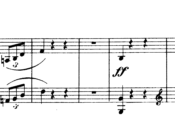Analysis
Presto
Form: Free Formal Structure. Ab Major
Bar 1-7: (Largo) Introduction, based around the dominant or dominant seventh chord of F minor (i.e. a C major chord), with some tonicisation of this chord (i.e. temporarily sounding in C major in Bar 3 and Bars 5-7). Ends with a pause on the dominant chord of F minor.
Bars 8-22: (in tempo) First theme, beginning in F minor. The theme begins with alternating tonic and diminished seventh chords, over a tonic pedal (Bars 8-10).
Modulates to A flat major (relative major, Bars 11-15, with a perfect cadence in Bars 11-12 and a tonic pedal in Bars 12-15), then B flat minor (subdominant, Bars 15-22, with an imperfect cadence in Bar 18, a dominant pedal in Bars 19-21, and a perfect cadence in Bar 16 and Bars 21-22).
Returns to F minor at the end of Bar 22.
Bars 23-37: First theme restated, with small embellishments (e.g. Bar 24), moving from F minor to A flat major (Bar 26), and B flat minor (Bar 30).
Bars 38-57: Interlude. Begins with a sequence in G flat major (Bars 38-41) and F flat major (Bars 42-45).
There is a reference to the first theme in E flat minor in Bars 46-49 (mezza voce).
A cycle of fifths progression (E flat – E flat – A – D flat – G flat – C in the bass) in Bars 50-52 leads to a return of B flat minor in Bars 53-57. Bars 56-57 are similar to Bars 21-22.
Bars 58-80: First theme restated, louder and denser than before, with a new alto countermelody. Moves from F minor to A flat major (Bar 61) and B flat minor (Bar 65).
Becomes more intense in Bars 68-71, and the expected perfect cadence at the end of these bars is replaced by accented diminished seventh chords (Bars 70-71).
A sequence, containing many seventh chords (Bars 72-73) leads to the dominant seventh of B flat in Bar 74. Bars 74-80 move from B flat minor to B flat major.
Bars 80-99: Second theme, B flat major (subdominant major). A short introductory motive (Bars 80-84) leads to the second theme proper (dolce).
The theme is harmonized in B flat major, with some chromaticism (e.g. secondary dominant sevenths of G minor in Bar 84 and E flat major in Bar 88, diminished sevenths in Bar 87, chromatic passing notes in Bar 93, etc.).
Each main cadence is preceded by a cycle of fifths progression (E – A – D – G – C – F – B flat in Bars 81-84, G – C – F – B flat in Bars 90-92 and 98-99).
Bars 100-128: Interlude. Begins with sequences in G minor (Bars 100-103) and A minor (Bars 104-107), then in G minor (Bars 108-109) and F minor (Bars 110-111) before settling in A flat major (from Bar 112, with some secondary dominant sevenths of D flat in Bar 112 and 114, and frequent dominant-tonic progressions in A flat major in Bars 113, 115, etc.).
There are references to the first theme in Bars 121-124, and to the introduction in Bars 125-128, with an enharmonic change in Bar 128 (A flat becomes G sharp).
Bars 129-134: Introductory theme returns, based around the dominant chord of D minor (i.e. an A major chord), with a short cadenza in D minor, in Bar 134.
Bars 135-151: First theme (slightly altered at first), beginning in D minor, with canonic imitation between the hands.
Modulates to F major (Bar 138), F minor (Bars 139-140), A flat major (Bars 141-142), A flat minor (Bars 143-144) and B flat minor (from Bar 145). Bars 146-151 are very similar to Bars 17-22.
Bars 152-168: First theme, with florid embellishments. Moves from F minor to A flat major (Bar 155) and B flat minor (Bars 159), settling on the dominant seventh of B flat in Bar 167, followed by a chromatic scale which links to the second theme.
Bars 169-194: Second theme, D flat major. There is a more active bass line (leggiero), and cross rhythms are used in the melody in Bars 175-176.
The first half of the theme ends with a perfect cadence in Bars 176-177.
The second half of the theme is extended, and is much louder and more expansive than before, leading to another perfect cadence in Bras 190-191 and a tonic pedal in Bars 191-194.
Bars 195-202: A French augmented sixth chord in Bar 194 (D flat – F – G -B) leads to a return to F minor from Bar 195. There is frequent use of chromatic harmony in this passage (e.g. in Bar 196 there is a secondary dominant seventh of G flat [D flat – F – A flat – C flat] and a Neapolitan sixth chord [B flat -D flat – G flat], and in Bar 202 there is a secondary dominant of C).
Bars 203-210: Chorale interlude, above a dominant pedal.
Bars 211-239: Coda, all in F minor. There is frequent chromaticism in Bars 211-226, and diminished sevenths predominate in Bars 215-216, but there is no further modulation. The key is reinforced by many dominant-tonic progressions, the main ones being the perfect cadences in Bars 226-227 and 238-239.







